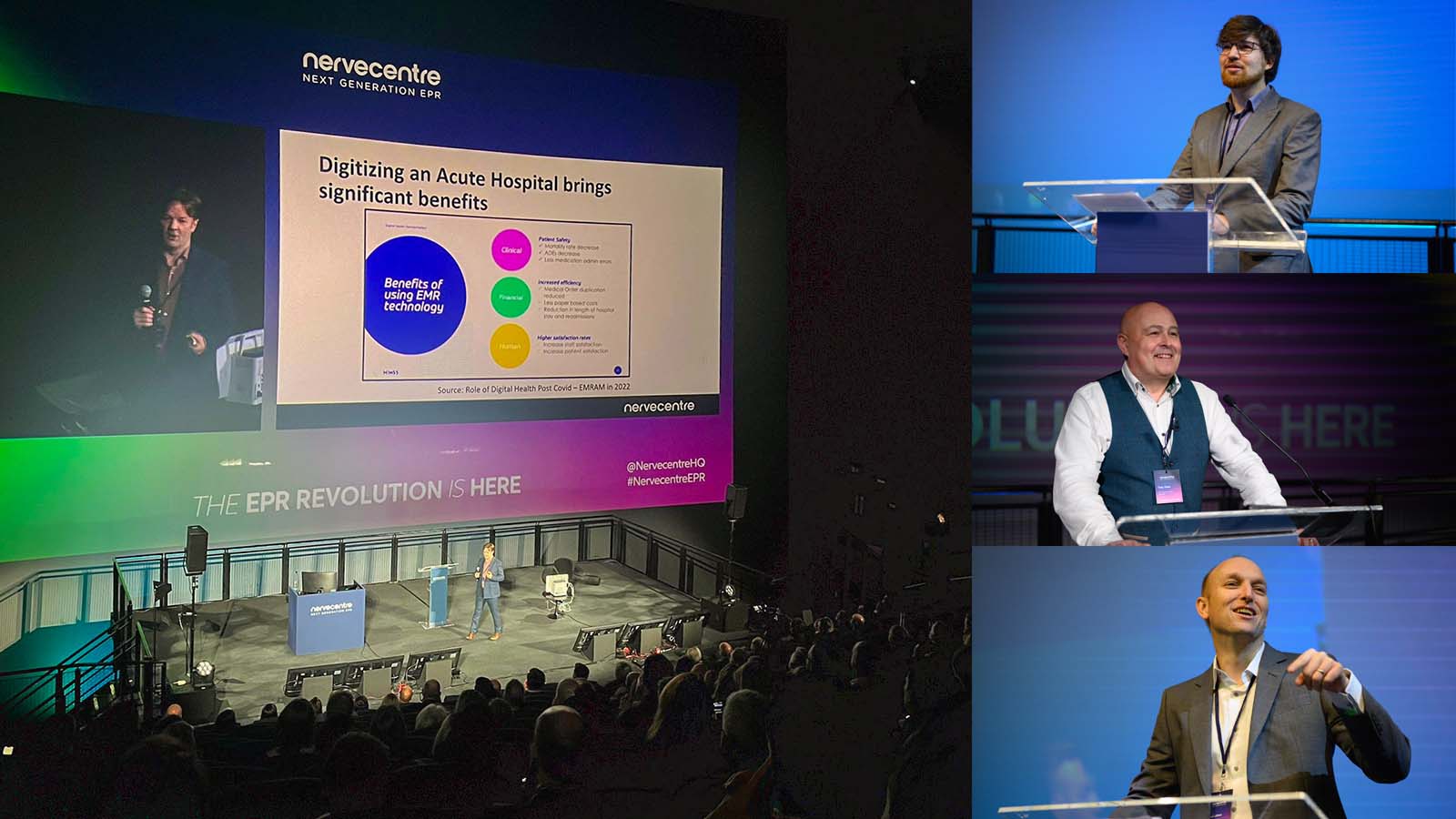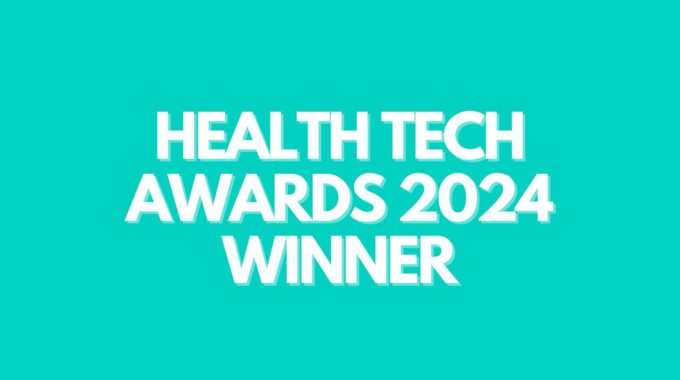A wave of NHS trusts is set to transform care at scale, fueled by Nervecentre’s…
The World of EPRs has Changed: Nervecentre at the Science Museum
Nervecentre recently took over the incredible IMAX theatre at the Science Museum to showcase a new breed of EPR that:
- drives transformation through class-leading usability
- uses cloud technology to break down walls between acute, mental health and community trusts, enabling cross-provider pathways
- is fully featured, with everything together in one place
Nearly 300 people from more than 80 NHS trusts and healthcare organisations packed the theatre to discover how the world of EPRs has changed.
Beyond the Enterprise EPR
In his opening keynote, Nervecentre CEO Paul Volkaerts stressed the importance of grasping the transformational opportunities of digitisation. The benefits of digitising hospitals are great, but Paul asked, “Does the transformation of hospitals naturally lead to the transformation of the NHS?”
Paul explained that to achieve system-level healthcare transformation, you must balance the fundamental first requirement of a broad feature set with essential architectural elements, summarised as four enabling transformational technologies:
- Cloud scale and agility
- Mobile and usability
- Patient engagement
- Big data and AI
In his conclusion, Paul said,
Our goal is to be the first EPR that combines feature breadth with these technological building blocks, to go beyond the enterprise EPR and enable the transformation the NHS needs.
Collaboration at scale
Next on the stage was Richard Mitchell, Chief Executive of University Hospitals of Leicester NHS Trust and University Hospitals of Northamptonshire NHS Group.
Richard described an exceptionally tough working environment within the NHS.
I believe the NHS needs radical change. I think technology, and in particular the focus on Nervecentre, is incredibly important, and it will enable us to deliver that radical change. The work we are doing with Nervecentre enables us to look after people more effectively, enables us to take difficult decisions, and I believe it gives people optimism and hope.
After running independent procurements, many of the acute trusts in the region are either already using Nervecentre or have selected Nervecentre as their preferred EPR. Regarding the opportunity this creates to collaborate, Richard said,
Working at scale in partnership with other acute providers, with community settings, general practice, and others will enable us to deliver some really important things.
Patientcentre
The IMAX stage was the perfect place for Paul Latimer to launch Patientcentre, Nervecentre’s new patient engagement platform that puts them at the centre of their care.
He explained that patients have higher expectations than ever before. They don’t want care ‘done to them’ but want to be an active participant instead – to be in control.
Highlights of Paul’s Patientcentre demonstration included:
- An intuitive and accessible patient app that uses NHS login
- Showing how patients can view letters, results and interventions, and manage appointments
- Asking patients to record and send back health information, such as blood pressure, and writing the results back to the EPR as part of a continuous record of care
Paul showed how easy it is for clinicians to interact with patients. The clinical side of Patientcentre is embedded within existing workflows, and everything is together in one place.
Everything together in one place
A running theme throughout the day was ‘everything together’. Vicki Kaluza showed us how Nervecentre is an established and full-breadth EPR with a single interface.
She demonstrated an emergency care pathway from pre-admission in the ambulance to discharge. The pathway traversed many of Nervecentre’s facets, such as ED, EPMA, order comms, obs, noting, charting, tasks, pathways, and Patientcentre.
The Data Driven Hospital
Our second guest speaker of the day was Nottingham University Hospitals’ Deputy Medical Director and Critical Care Consultant, Dr Mark Simmonds. Mark’s inspirational session described his first-hand experience of capturing consistent and complete healthcare data and using it to enable agile and responsive service design.
He described several examples of how Nottingham uses Nervecentre data and AI to improve care, including:
- An up-to-the-minute live picture of their bed state, which gives them the ability to see both supply and demand
- A discharge live flow stream that shows what people are waiting for in real-time
- Within two weeks of COVID hitting the UK, Nottingham could track every single COVID patient. Mark said, that from the patients with COVID arrived at the hospital, they knew where they were, how many there were, where they were going, and what they were doing with them, to the extent that it utterly changed the way they designed the hospital.
- Working with external partners, they could predict how many COVID patients they would have the next week.
- Using AI to predict medically safe dates
PAS
The next demonstration, delivered by Eisha Gandhi, Ruth Yates and Tony Jukes, was a deep dive into Nervecentre’s PAS.
We believe ours is the only PAS designed in the 21st century, maybe even a decade longer. That’s really important; we expect your needs from a PAS will be radically different over the next five years compared to the past thirty years. That’s why our PAS is designed to cope with complex patient journeys, moving away from ‘new versus follow-up’ being all you know about why a patient sees you to understanding why a patient is there for every single interaction.
Outpatients and Planned Care
Following on, Dr Sam Thacker showed us how the PAS interacts with Nervecentre’s clinical features to complete a true next-generation EPR.
Highlights included:
- Seeing how information added during outpatient clinics creates a contiguous record alongside inpatient and patient-recorded data
- Citing blood tests, observations, previous clinic notes, letters, and referral details to create a ‘moment in time’ summary of the patient that the clinician might need in an outpatient clinic
- Multi-screen working, with one screen showing the patient list and the other showing the patient records.
Sometimes we talk about our product in terms of modules such as EPMA, outpatients, or ED. But while they can stand alone, we’re not building modules. We’re building a single record of care for a person, a person who is not bound by lines of software functionality or organisational responsibility.
The EPR revolution is here
The day finished on a high, showing how Nervecentre is the EPR that breaks down walls between suppliers.
Nervecentre’s data sharing is enabled by a modern cloud-based multi-tenant platform. It allows trusts to have precise control over what they share and don’t share using policies.
The real power of this approach to sharing was apparent when Amie updated a policy to include continuation forms. in an instant, this additional shared information appeared in the patient record alongside locally recorded information and data previously shared.
Amie summed this up beautifully,
You can see the process of patient data sharing is seamless, and that the user doesn’t have to go looking for the information – it appears with full context automatically.
The time for compromise is over
At the start of the day, Paul Volkaerts set out the vision of Nervecentre being the first EPR to provide the full feature set that providers depend upon, along with the technical architecture that enables interoperability, mobility, usability, agility, big data and NHS standards.
Nervecentre demonstrated it has the breadth of product to meet your EPR requirements and the platform-approach architecture to do exciting and unique things.
Post-event feedback included “My view that Nervecentre is a fast-challenging EPR supplier was solidified”, “very impressed with what I saw”, “I think Nervecentre will make a significant play for UK market share over the next 5 years”, and “The company has scaled to become a real player in the market”.
The time for compromise is over.





This Post Has 0 Comments